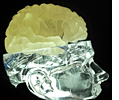Education & Training
Neurosurgeon and team 3D print model of patient’s brain
November 18, 2015
 SASKATOON – Dr. Ivar Mendez, head of surgery at the University of Saskatchewan, has managed to print a 3D replica of a patient’s brain as a way of rehearsing a surgery to achieve an optimal result. Dr. Mendez worked with a team to produce the model, which is an exact replica of a specific patient’s brain.
SASKATOON – Dr. Ivar Mendez, head of surgery at the University of Saskatchewan, has managed to print a 3D replica of a patient’s brain as a way of rehearsing a surgery to achieve an optimal result. Dr. Mendez worked with a team to produce the model, which is an exact replica of a specific patient’s brain.
When conducting brain surgery, Dr. Mendez has been making use of computerized imaging software to plan the best routes – hitting his target areas and avoiding other structures during procedures such as deep brain stimulation.
However, the brain mapping software he’d been using was not doing the job.
Instead, Dr. Mendez decided to see if he could generate a computer model of the brain and 3D print it so he could see exactly where he needed to go and hit the target areas accurately.
He approached the school of engineering at the University of Saskatchewan for help. Soon he had assembled an entire team of engineers, MRI technicians, neuropsychology specialists and a radiologist to help translate the MRI data.
It ended up taking Dr. Mendez and his team over seven months before they were able to successfully 3D print their first prototype. While the prototype included all of the required complexity, including the small nuclear structures, the rubber-like material wasn’t clear enough to see through.
After testing several more materials and printing several more iterations, Dr. Mendez and his team finally found the correct process and they were able to 3D print an accurate replica of a human brain, that would allow him to successfully map the deep brain stimulation procedure.
The final model brain was printed with a synthetic rubber material that almost exactly simulates the consistency of real brain tissue. The final model is slightly less jiggly than you would imagine it to be, but it is still flexible and can be compressed by gently squeezing it, but firm enough to pop back into shape when released.
It is also completely clear and even has the target area printed in a different color, making it easier to plan the correct surgical path.
3D printed organ models are a relatively new tool available to surgical teams, however they have been proven to be invaluable in planning exceptionally difficult and dangerous procedures.
While similar procedures have been used for other organs like the human heart, this was the very first time that a 3D printed model of the brain was used for surgical pre-planning.
